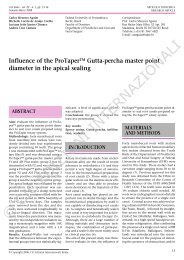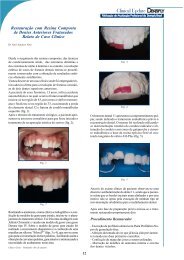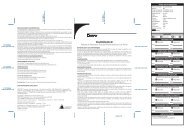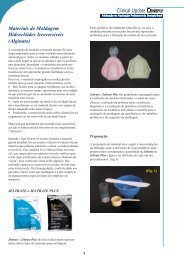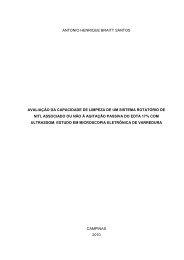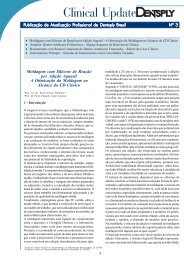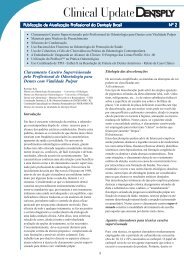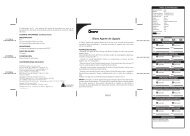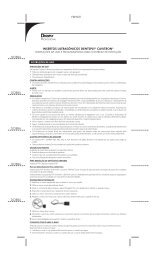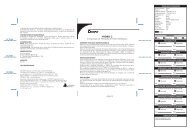You also want an ePaper? Increase the reach of your titles
YUMPU automatically turns print PDFs into web optimized ePapers that Google loves.
Raffaelli et al<br />
Fig 1 Bond strength values (without<br />
premature failures) and percentage of<br />
premature failures (ptf) of the seven<br />
tested groups. NC: not cured; LC: light<br />
cured; DC: dual cured; CC: chemically<br />
cured.<br />
The results of this study demonstrated that the thickness<br />
of the porcelain restoration does not affect the polymerization<br />
of the adhesive/luting combination: in the three groups<br />
(3 to 5) in which the thickness of porcelain disks was 2, 3,<br />
and 4 mm, respectively, the bond strength values were between<br />
23.6 and 30.3 MPa with a progressive increase of<br />
bond strength proportional to the porcelain thickness. This<br />
could be due to the efficacy of the self-curing mode of the<br />
new bonding material and/or to the intrinsically greater<br />
strength of thicker porcelain. This result should lay to rest<br />
any doubts that a thick ceramic restoration cannot be luted<br />
using a one-bottle system in combination with a resin cement.<br />
The results also suggest that XP BOND can be considered<br />
a proper bonding system for luting full and partial porcelain<br />
crowns. In order to simplify the clinical luting procedures and<br />
according to the results of this study, XP BOND and Calibra<br />
resin cement can routinely be used in the self-curing mode.<br />
A study on the clinical performance of XP BOND cured by the<br />
application of its self-activator and used in combination with<br />
Calibra resin cement is currently ongoing.<br />
CONCLUSIONS<br />
From the results of this study the following conclusions can<br />
be drawn:<br />
XP BOND can be used in the self-curing mode in combination<br />
with SCA and Calibra resin cement for luting porcelain<br />
restorations.<br />
The porcelain restoration thickness is not a limitation to<br />
the curing process of the adhesive-luting material combination<br />
when XP BOND is self-activated.<br />
ACKNOWLEDGMENTS<br />
This research was sponsored by <strong>Dentsply</strong> DeTrey, Konstanz, Germany.<br />
REFERENCES<br />
1. Bergman MA. The clinical performance of ceramic inlays: a review. Aust Dent<br />
J 1999;44:157-168.<br />
2. Davidson CL. Luting cement, the stronghold or the weak link in ceramic<br />
restorations. Adv Engineer Mater 2001;3:763-767.<br />
3. De Munck J, Vargas M, Van Landuyt K, Hikita K, Lambrechts P, Van Meerbeek<br />
B. Bonding of an auto-adhesive luting material to enamel and dentin. Dent<br />
Mater 2004;20:963-971.<br />
4. Hahn P, Schaller HG, Hafner P, Hellwig E. Effect of different luting procedures<br />
on the seating of ceramic inlays. J Oral Rehabil 2000;27:1-8.<br />
5. Pashley DH, Pashley EL, Carvalho RM, Tay FR. The effects of dentin permeability<br />
on restorative dentistry. Dent Clin North Am 2002;46:211-245.<br />
6. Shono Y, Terashita M, Shimada J, Kozono Y, Carvalho RM, Russell CM, Pashley<br />
DH. Durability of resin-dentin bonds. J Adhes Dent 1999;1:211-218.<br />
7. Tay FR, Frankenberger R, Krejci I, Bouillaguet S, Pashley DH, Carvalho RM,<br />
Lai CN. Single-bottle adhesives behave as permeable membranes after polymerization.<br />
I. In vivo evidence. J Dent 2004;32:611-621.<br />
8. Tay FR, Pashley DH, Suh BI, Hiraishi N, Yiu CK. Water treeing in simplified<br />
dentin adhesives - déjà vu Oper Dent 2005;30:561-579.<br />
9. Tay FR, Pashley DH. Dental adhesives of the future. J Adhes Dent 2002;4:91-<br />
103.<br />
10. Van Meerbeek B, De Munck J, Yoshida Y, Inoue S, Vargas M, Vijay P, Van Landuyt<br />
K, Lambrechts P, Vanherle G. Buonocore memorial lecture. Adhesion to<br />
enamel and dentin: current status and future challenges. Oper Dent<br />
2003;28:215-235.<br />
Clinical relevance: The results of this microtensile investigation<br />
show good performance of XP BOND in its self-curing<br />
mode.<br />
278 The Journal of Adhesive Dentistry



